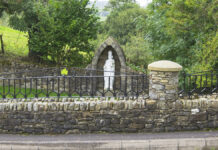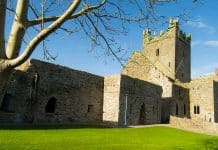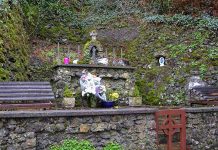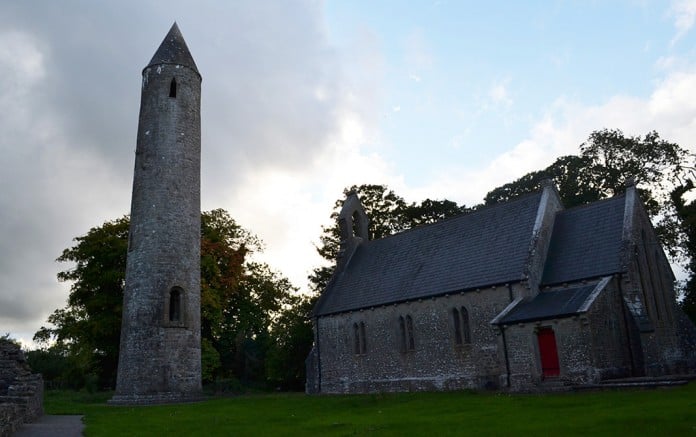
The Timahoe Round Tower is surely one of the most finest historical settings in all Ireland. Standing on the site of an ancient monastery that was once home to St. Mochua, the tower has dominated the verdant landscape of County Laois for centuries and has a timeless atmosphere that makes it a true pleasure to visit. A recent addition is a sculpture known as St Mochua’s Desk, the design of which reflects the myths associated with the holy man himself.
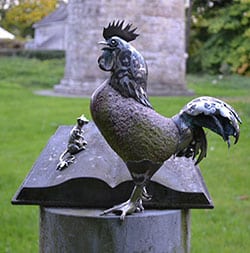
The original monastery on the site of the Timahoe Round Tower is believed to have been established back in the seventh century AD by the O’Mores. It was the home of St. Mochua, a renowned warrior who latterly turned to Christianity and decided to live the rest of his life as a hermit. He was said to possess no worldly goods at all, except for his precious psalter (a devotional volume comprising the Book of Psalms and other religious reference materials), a single rooster, a fly and a mouse. The legend tells that the rooster crowed to alert him it was time to pray, the fly kept his place in the psalter when he was reading his holy texts, and the mouse would lick his ears should he fall asleep while at his devotions, ensuring that he could never sleep more than three hours in any one night (the story that inspired the commission of the St Mochua’s Desk sculpture in the grounds). St. Mochua’s dwelling was originally called Teách Mochua, which came to be known over time as Timahoe.
It is known that a holy community existed at Timahoe as late as 1650. It was at around that time that Cromwell’s much-feared General Hewson, amongst many other barbarous acts, murdered all of the monks and reduced their house to ruins. The place where the friars were slaughtered is known to this day as ‘the road of murder’.
The striking tower, constructed at some point during the early 12th century, is the only part of the original monastery that still stands today. Its proportions are impressive – it stands 96 feet high and at its base is more than 17 metres in circumference. The walls themselves are just over a metre in thickness. Inside the tower there are five floors, which would have been navigated by the monks using ladders.
It boasts an absolutely stunning ornately Romanesque double doorway, positioned around five metres above ground level. This features beautiful adornments, including heads with flowing entwined hair, moustaches and beards and intricately interlaced chevrons. Smaller but no less impressive carvings adorn one of the windows on the second storey.
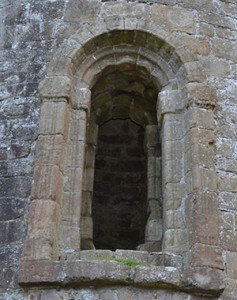
It is not known why the monks carved such an intricately complex doorway. One theory is that they may have used it as a place to display their sacred relics to passing pilgrims. It is also perfectly possible that the entire monastery was once decorated to this standard, although we will obviously never know for sure.
Eminent scholars have debated the use of this type of Irish round tower for many centuries. It is probable that the towers had multiple uses, including as look-out posts from which to get early warning of approaching Viking raiders and also as bell houses (when translated into English, ‘Cloig Teách’ means ‘bell house’). The height of the towers would also have meant that they acted as a beacon to weary travellers, who would have known that they were near a place of sanctuary where they could sleep and be fed.
The friars would have been called to prayer when the bells tolled, and they would also ring out when the monastery was attacked. We can well imagine the scene when the alarm bell sounded: the monks scrambling to gather together all their holy treasures, bolting the door securely and climbing the ladders to the upper floors, pulling them up after them.
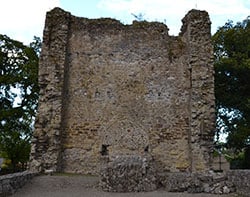
Following the Dissolution of the Monasteries in the mid-16th century (a dark period when monasteries were abolished and their treasures were taken by the state), the monastery and all of its lands were settled on Sir Thomas Loftus and then later on, in 1609, on Richard Cosby. It is believed that it was a member of the Cosby family who converted the monastery into a defensive castle. Today, the east wall, which incorporates an arch from the original church, is the only part of the castle that remains.
An arresting sculpture in the grounds of the Timahoe Round Tower was custom-made following a request from the local primary school. It is called St Mochua’s Desk and depicts St Mochua and his three loyal companions – the rooster, the fly and the mouse.
A visit to the Timahoe Round Tower and St Mochua’s Desk is an unforgettable experience. The legend of St. Mochua and what we know of his history allows us to glimpse back through the eerie mists of Irish time.

